Miami-Opa Locka Executive Airport (OPF)
Miami-Opa Locka Executive Airport (OPF) is a medium sized primarily general and business aviation airport located in Miami-Dade County Florida. It is also home to the Miami Coast Guard station with its fleet of fixed and rotor wing aircraft. OPF is just six miles north of the larger Miami International Airport (MIA) and five miles south of the North Perry (HWO) airport. The runway configuration consists of parallel RWY's 9/27 L/R and non-intersecting RWY 12/30 which is located between the parallels. View a printable Pilot Handbook of the OPF information found on this Web page.
Know Before You Go
OPF Tower Hours of Operation – 0700L-2300L
Administrative Office Open 0700L to 1500L M-F
Business Phone 305-869-1601
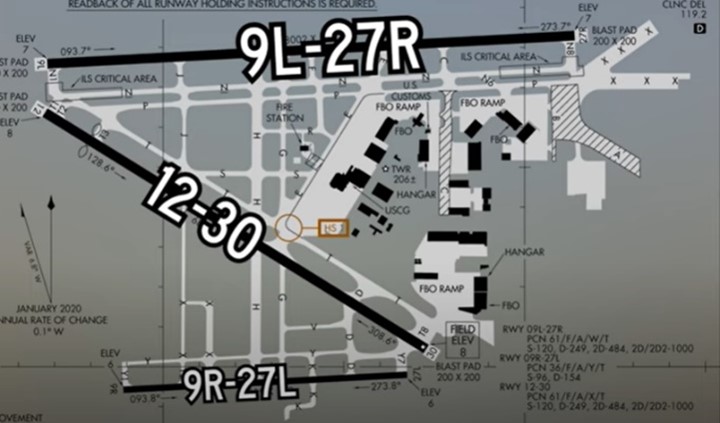
The airspace at OPF is Class D and is adjacent to and underlies the MIA Class Bravo airspace. It is also adjacent to the HWO Class Delta airspace to the north. (Refer to Sectional Chart.)
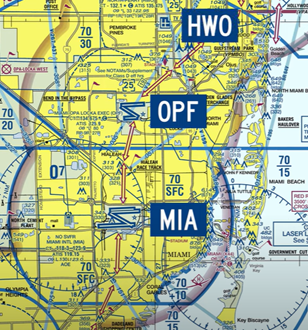
Below find various OPF-specific information and things to be aware of, as well as general information to inform your preflight planning. This will be reviewed quarterly and updated as needed. This information is to supplement the From the Flight Deck Videos that are produced by the FAA Runway Safety Group. Here you will also find information provided by the local air traffic controllers at the airport where you intend to fly. The information is subject to change. Not for navigation or legal* pre-flight action. Always refer to official pre-flight materials such as, but not limited to, NOTAMs, airport diagrams, VFR charts and airport construction notices for the latest airport-specific details.
Hot Spots
- HS 1 Short taxi ramp to runway risk. Large pavement area with only surface painted location and direction signs.
- As a result of the large pavement area, it does not allow for above ground signage. Pilots who become confused could easily end up in an incursion of RWY 12/30.
- Pilots should familiarize themselves with the taxi route issued prior to taxiing.
- If in doubt of your clearance, instruction, or location, do not hesitate to ask Ground Control.
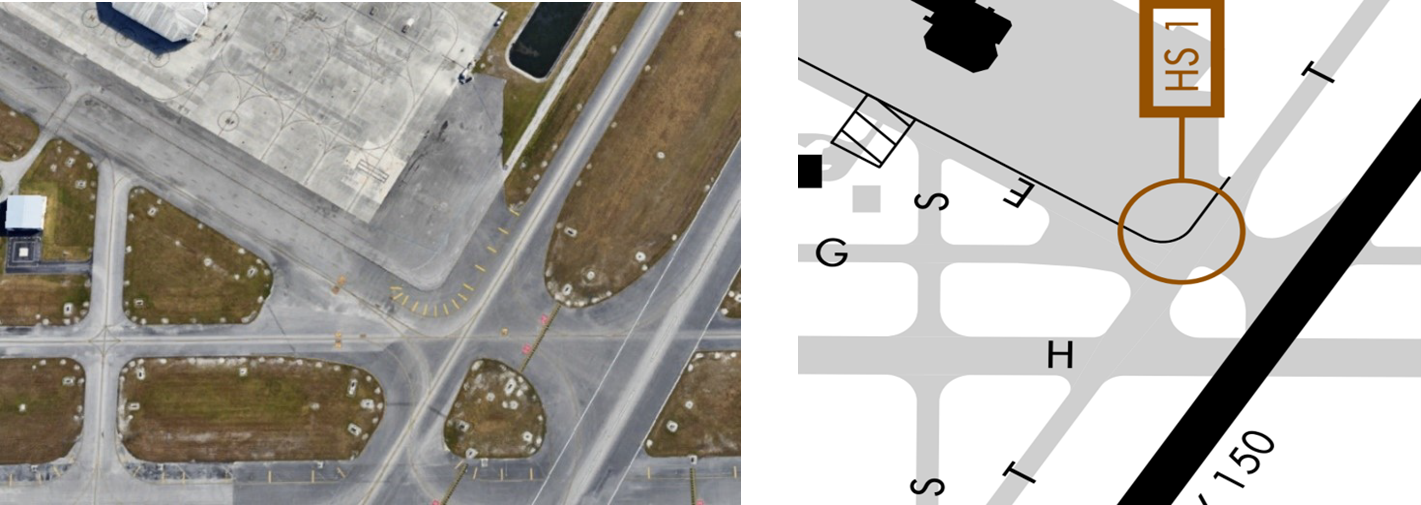
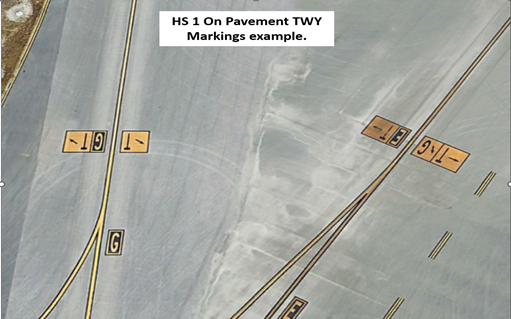
Wrong Surface Landings - See Arrival Alert Notices.
- A Wrong Surface Landing risk exists due to parallel RWY’s with staggered thresholds.
- There are full-length parallel TWY’s at OPF.
- Runway Markings are White. Surfaces not used for Takeoff/Landing like Taxiway Markings, Chevrons, Runway Shoulder, and Runway Turn-on Markings, etc., are Yellow. (See illustration below.)
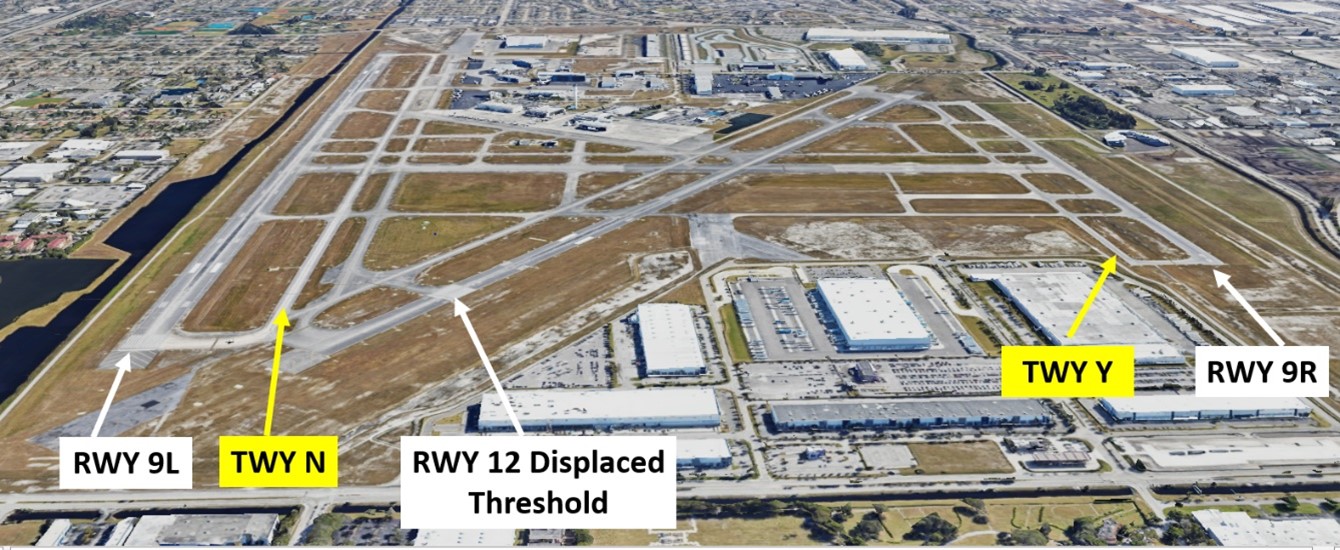
Wrong Surface Landing risk also exists due to the proximity of the approach ends of RWY 9L and RWY 12. Pilots, cleared to land on RWY 9L, have landed on RWY 12 and vice versa. Similarly, at the other end of the airport, the proximity of the approach ends of RWY 27L and RWY 30 have caused pilots to land on the adjacent RWY. (See illustration below.)

- Expectation bias or just the first RWY pilots see can lead to wrong surface landings.
- Pilots should verify that the heading on final aligns with the assigned landing RWY.
- Loading an instrument approach to the assigned RWY will help pilots ensure they are landing on the proper surface.
Wrong Airport Landings
- A Wrong Airport Landing risk exists between OPF and MIA. The airports are six miles apart with similar runway configurations.
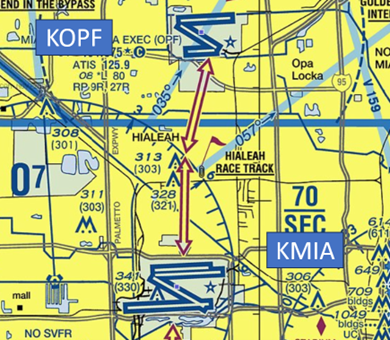
Wrong Runway Takeoff
- A taxi challenge sometimes occurs at the intersection of TWY's T/T1/T2 and TWY's N/N1.
- Aircraft taxing for departure on either RWY 9L or RWY 12 have become confused and attempted to take off on the wrong RWY.
- Pilots should verify proper heading prior to starting takeoff roll on all departures. Always check the magnetic compass / Horizontal Situation Indicator (HSI) to confirm departure in the proper direction.
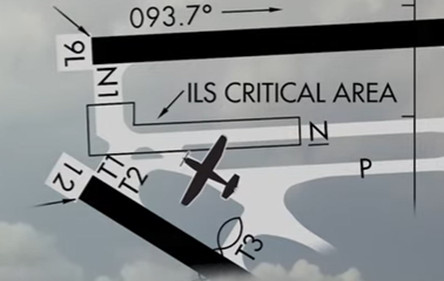
General
- Clearance Delivery is frequently combined with Ground Control. For the correct frequency, please listen to the ATIS before getting clearance.
- Aircraft requiring a high-power run-up must coordinate with the Miami-Dade Aviation Department to schedule a time. Contact them at 305-439-2696.
- Use caution there is no above-ground signage at Hotspot 1. All TWY markings are on the pavement.
- Due to geography, there is increased bird activity at the airport.
- All aircraft and vehicles should report positions to ATC by using the surface painted spot numbers on all exits to the ramp and non-movement areas.
Traffic Patterns
- Pattern work is typically conducted on RWY 9R/27L only. Verify traffic pattern direction with ATC as there may be multiple aircraft in the pattern.
Ground Control
- Aircraft requiring a run-up before departure must inform Ground Control on initial contact. The designated run-up area is on TWY H between TWY P and TWY R.
- Single-piston and twin-engine aircraft should advise Ground Control on initial contact if they will depart IFR.
Takeoff/Departure
- Line-up and wait (LUAW) is not allowed at OPF. Pilots will be issued a takeoff clearance while holding short of the runway.
Avoidance Areas
- VFR aircraft need to be aware of the MIA Class B and HWO Class D airspace and avoid entering those areas without permission.
- VFR aircraft departing to the northwest should remain clear of the final for RWY 12 due to heavy IFR traffic inbound.
Arrival/Landing
- VFR single and twin prop aircraft will frequently be assigned RWY 9R/27L due to heavy IFR arrivals and departures off RWY 9L/27R.
- VFR practice approaches frequently get turned out early due to heavy IFR departure demands.
- VFR aircraft arriving from the west need to remain clear of the final for RWY 9L and RWY 12 unless instructed by the tower. The recommended VFR altitude is 1,000 feet within 10 miles of the airport due to heavy jet traffic on approaches at 1,600.
- Aircraft landing RWY 9R/27L remain on TWR frequency until instructed to contact Ground Control.
Special Traffic (Military / Commercial / Helicopter, etc.)
- There are established helicopter routes in and outbound between the parallels at or below 500 feet.
- Pilots can obtain traffic pattern information from the Airport Authority, FBO’s or on initial contact with TWR.
- Helicopters arriving and departing should avoid flying over parked or taxiing aircraft.
Additional Information
- Knowing and advising TWR of where you want to park will assist controllers in getting you to that location more expeditiously.
- Dual traffic patterns for helicopters and fixed wing aircraft in use on RWY 9R/27L.
NOTAMS
- Check NOTAMS to view:
- Construction Notice indicating TWY Closures and RWY Restrictions
- LTA-MIA-14 detailing VFR Practice Instrument Approach Procedures
